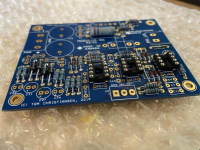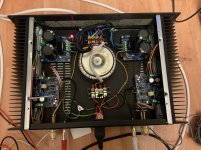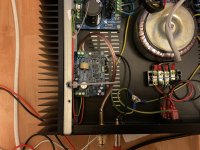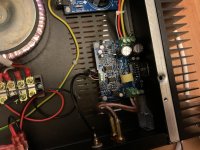Mouser has some stock issues for certain parts as well. Some parts will be in backorder for a few months. For a large order, they give free shipping in batches of availability though so it doesn't bother me too much. If I get impatient I will look for the missing parts at Digi-Key or some other place.
Hi guys, I just found this very interesting and loooong tread.
I did not have time to read all postings so if my post duplicates some other posts, please ignore it.
I'm sorry for the long introduction but otherwise would be difficult to get to my point.
INTRODUCTION
There are many well known advantages of the composite topology.
Current sharing (paralleling) approach offers great benefits as well.
That is why combining both sounds very compelling.
Some time ago I built a composite amplifier based on LM1875. Here is a brief summary:
- THD and noise bellow -125dB (the limit of my measuring gadgets) 0.1 to 40W - 2 parallel LM1875 amps
- less then 1mv DC output, usually between 0.2 and 0.5mV.
- no servo
- no Feedback DC decoupling
- stable in wide range of supply voltages (up to +-30V)
- unity gain stable (not good idea though because of the high CM distortion)
- easy to get up to 150W /8ohm combining parallel and bridge 6 LM1875.
- no trace of annoying current limiting feature
Here ends the introduction .
.
I have built a big number of these amps and the sound quality easily beats many other power amps that I owned during the years, including:
- Hypex UCD 250 equipped with super regulators,
- ICEpower 200AC
- TPA3251 and TPA3255 with air coil output filters (the original boards came from 3e-audio but to get a decent sound I had to mod the output filters and input stage as well)
- different LM3886 and TDA7293 topologies (Not composite amps, for these I'll share me exiting experience some other time).
BUT I did not have the opportunity to compare my amps with the well regarded Modulus-86 power amp,
I'll be very happy to do that!
I live in west LA and if somebody of the community lives in that area and owns modulus-86 amp I'd be very happy to meet and make some critical listening.
I did not have time to read all postings so if my post duplicates some other posts, please ignore it.
I'm sorry for the long introduction but otherwise would be difficult to get to my point.
INTRODUCTION
There are many well known advantages of the composite topology.
Current sharing (paralleling) approach offers great benefits as well.
That is why combining both sounds very compelling.
Some time ago I built a composite amplifier based on LM1875. Here is a brief summary:
- THD and noise bellow -125dB (the limit of my measuring gadgets) 0.1 to 40W - 2 parallel LM1875 amps
- less then 1mv DC output, usually between 0.2 and 0.5mV.
- no servo
- no Feedback DC decoupling
- stable in wide range of supply voltages (up to +-30V)
- unity gain stable (not good idea though because of the high CM distortion)
- easy to get up to 150W /8ohm combining parallel and bridge 6 LM1875.
- no trace of annoying current limiting feature
Here ends the introduction
I have built a big number of these amps and the sound quality easily beats many other power amps that I owned during the years, including:
- Hypex UCD 250 equipped with super regulators,
- ICEpower 200AC
- TPA3251 and TPA3255 with air coil output filters (the original boards came from 3e-audio but to get a decent sound I had to mod the output filters and input stage as well)
- different LM3886 and TDA7293 topologies (Not composite amps, for these I'll share me exiting experience some other time).
BUT I did not have the opportunity to compare my amps with the well regarded Modulus-86 power amp,
I'll be very happy to do that!
I live in west LA and if somebody of the community lives in that area and owns modulus-86 amp I'd be very happy to meet and make some critical listening.
Until today, I have ignored SMPS 100% as an option for my amplifiers. Apparently, it was more because of "religious" factors than scientific ones. The design of the Neurochrome preamp power supply got me curious so I did some reading.
Fast forward, I am now considering to power my stereo Modulus-86 build with an SMPS power supply. The design documentation mentions a double Mean Well RPS-200-27-C possibility, without the Mean Well Control module. Is the Mean Well Control module meant for a different setup (a Modulus-686 build maybe)?
I also looked at the SMPS-86 but it seems discontinued (because of competitive/good enough alternatives?). I'm also looking at the Connex SMPS300REh. It seems to fit the requirements nicely: enough power and +/- 30v out of the box. It also has a metal heat sink as a bottom plate which I like, I don't want to introduce a fan in my amplifiers.
Looking at photos of SMPS builds, there are builds with and without a soft start in front of the SMPS. I don't know how to relate SMPS to transformer sizes or whatever, so is a soft start recommended for a 300 watt SMPS?
Fast forward, I am now considering to power my stereo Modulus-86 build with an SMPS power supply. The design documentation mentions a double Mean Well RPS-200-27-C possibility, without the Mean Well Control module. Is the Mean Well Control module meant for a different setup (a Modulus-686 build maybe)?
I also looked at the SMPS-86 but it seems discontinued (because of competitive/good enough alternatives?). I'm also looking at the Connex SMPS300REh. It seems to fit the requirements nicely: enough power and +/- 30v out of the box. It also has a metal heat sink as a bottom plate which I like, I don't want to introduce a fan in my amplifiers.
Looking at photos of SMPS builds, there are builds with and without a soft start in front of the SMPS. I don't know how to relate SMPS to transformer sizes or whatever, so is a soft start recommended for a 300 watt SMPS?
The SMPS-86 was discontinued because it didn't provide enough power to drive the Modulus-86 to clipping with a 4 Ω load. Also, with the Connex SMPS300REh and the Mean Well RPS-series there are better options on the market now.
The Mean Well Control will probably be discontinued. It only works with the RPS/RPP-300/400 series, so not with the 200-series. Also, the Mean Well supplies will power up as soon as they're plugged into the mains voltage, so they can be controlled by an ISS instead.
The Connex SMPS300REh has a built-in soft start, but do note that it still draws quite an inrush current on startup. I had it burn out a 2A rated mains switch during the prototyping of the Modulus-286 Kit (LE). I would use an ISS to control the mains power to it. That also gives you a range of nice features, including a 12 V trigger input, option to use low-voltage switches, dual LED dimmers for ON and STANDBY indication, etc. And soft start, of course.
Tom
The Mean Well Control will probably be discontinued. It only works with the RPS/RPP-300/400 series, so not with the 200-series. Also, the Mean Well supplies will power up as soon as they're plugged into the mains voltage, so they can be controlled by an ISS instead.
The Connex SMPS300REh has a built-in soft start, but do note that it still draws quite an inrush current on startup. I had it burn out a 2A rated mains switch during the prototyping of the Modulus-286 Kit (LE). I would use an ISS to control the mains power to it. That also gives you a range of nice features, including a 12 V trigger input, option to use low-voltage switches, dual LED dimmers for ON and STANDBY indication, etc. And soft start, of course.
Tom
Kdent,
Cool and keep us posted on your progress.
I built my Modulus-86 shortly after Tom launched the product. Tom's PCBs were done in green at that time - I think the new ones look a bit nicer . I have enjoyed many (delightful) hours of listening to music with the Mod-86 in my system.
. I have enjoyed many (delightful) hours of listening to music with the Mod-86 in my system.
Last but not least, I found Tom's documentation and support top notch.
Cool and keep us posted on your progress.
I built my Modulus-86 shortly after Tom launched the product. Tom's PCBs were done in green at that time - I think the new ones look a bit nicer
Last but not least, I found Tom's documentation and support top notch.

Last edited:
I built 4 channels of Modulus-86 for an open baffle project. Tom was really helpful, worth the cost of the boards just for the support I received. I had built a few kit amps before but, to my ears, the 86 left them in the dust. Such a detailed, transparent sound and no hiss at all.
Following that project, and loving the sound of the active crossover with Modulus-86 powered open baffles I wanted to go further. As I’m a bit of a novice I also wanted to be sure I was building the best I could so I purchased the LX521 plans. With Tom’s help on appropriately sized power supplies I built another 6 Modulus-86 boards to create my 10 channels for the LX521.
What I ended up with were not quite LX521s because I did make a few changes to the design, just cosmetically with hopefully minimal impact on the sound quality. To say I am happy with the results is an understatement, I can’t stop listening to music. I posted some more details on the Linkwitz forums, ORION/PLUTO/LX... Users Group • View topic - A no bridge build


The black metal chassis holds 6 channels and the curved timber amp has 4 channels.
Following that project, and loving the sound of the active crossover with Modulus-86 powered open baffles I wanted to go further. As I’m a bit of a novice I also wanted to be sure I was building the best I could so I purchased the LX521 plans. With Tom’s help on appropriately sized power supplies I built another 6 Modulus-86 boards to create my 10 channels for the LX521.
What I ended up with were not quite LX521s because I did make a few changes to the design, just cosmetically with hopefully minimal impact on the sound quality. To say I am happy with the results is an understatement, I can’t stop listening to music. I posted some more details on the Linkwitz forums, ORION/PLUTO/LX... Users Group • View topic - A no bridge build


The black metal chassis holds 6 channels and the curved timber amp has 4 channels.
Last edited:
I have been ranging far and wide on Tidal since finishing them. Jazz, classical, folk, the modern classics Pink Floyd, Talking Heads, Fleetwood Mac, U2. Everything just sounds so much better, I get drawn in and 2 hours later I'm still sitting there picking the next track.
My current demo track is London Grammar, Hey Now. In a fortunate coincidence an audiophile friend took me out comparison shopping for speakers on the weekend and the shop was using Hey Now in their demo setup. I listened to $10k+ speakers and then rush home and compare to my home build. Sure I'm biased but it was no contest.
My current demo track is London Grammar, Hey Now. In a fortunate coincidence an audiophile friend took me out comparison shopping for speakers on the weekend and the shop was using Hey Now in their demo setup. I listened to $10k+ speakers and then rush home and compare to my home build. Sure I'm biased but it was no contest.
Someone is building a pretty epic Modulus amp in this thread: Dual-Purpose Multichannel / Stereo Amplifier using Neurochrome Modules
Tom
Tom
mod-86 build issues
Hi Tom, I just finished assembling my mod-86.
powersupplies measured as expected. Finished connecting and turned on with lightbulb inline. no problem, all seemed nice. connected to my aikido tube pre and small car speakers I use when starting builds for the first time. got small sparks from audio input at the print both channels. Turned off. Cheked all connections all seemed ok. Turned on again, no sparks, no sound, no smell but ICs got hot. Turned off again. Cannot quite see what is wrong.
Hi Tom, I just finished assembling my mod-86.
powersupplies measured as expected. Finished connecting and turned on with lightbulb inline. no problem, all seemed nice. connected to my aikido tube pre and small car speakers I use when starting builds for the first time. got small sparks from audio input at the print both channels. Turned off. Cheked all connections all seemed ok. Turned on again, no sparks, no sound, no smell but ICs got hot. Turned off again. Cannot quite see what is wrong.
Attachments
Tom, I ran some youtube music through the amp late last night, sounded mighty fine. Has a tiny bit of mechanical noise from the transformer. I hear no other noise and I'm using a tube line stage and over 100dB/W speakers.
I will test with a better source this evening.
But all in all a great piece of kit.
Regards
Kjartan
I will test with a better source this evening.
But all in all a great piece of kit.
Regards
Kjartan
I used the mod-86 on my Altec A5s and my initial impression is wery good. They are fast but in a smooth and relaxed way similar to my First Watt class A amps. Dig out a lot of detail and spatial clues but are not aggressive in any way in my setup, which is quite revealing. I notice the bass on my altecs is a lot better than with f.ex. hypex nc400 and similar again with the bass from my DIY FW M2 amp (which is still somewhat better in that area). The altec 515s dont like too be too tightly controlled but the mod-86 still allows them to show their quality. I need to test the amps on my less effective speakers and to live with the amps for awhile. Still they are a great addition to my growing collection of superb DIY amps. I need to finalise my electronic crossovers so I can play around som more with amps and speakers.
Regards
Kjartan
Regards
Kjartan
- Home
- Amplifiers
- Chip Amps
- Modulus-86 build thread



